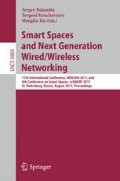Abstract
This article shows how to use Hidden Markov Models to generate self-similar traffic. The well-known Bellcore traces are used as a training sequence to learn HMM model parameters. Performance of trained model are tested on the remaining portions of the sequences.Then we can use the HMM trained with the Bellcore data as the traffic source model.
Access this chapter
Tax calculation will be finalised at checkout
Purchases are for personal use only
Preview
Unable to display preview. Download preview PDF.
References
Andersen, A.T., Nielsen, B.F.: A Markovian approach for modeling packet traffic with long-range dependence. IEEE Journal on Selected Areas in Communications 16(5), 719–732 (1998)
Willinger, W., Leland, W.E., Taqqu, M.S.: On the self-similar nature of ethernet traffic. IEEE/ACM Transactions on Networking (1994)
Klemm, A., Lindemann, C., Lohmann, M.: Modeling IP traffic using the batch Markovian arrival process. Performance Evaluation 54(2), 149–173 (2003)
Veitch, D., Abry, P., Flandrin, P., Chainais, P.: Infinitely Divisible Cascade Analysis of Network Traffic Data. In: Proceedings of IEEE International Conference on Acoustics, Speech, and Signal Processing (ICASSP 2000), Istanbul, Turkey, vol. 1 (June 2000)
Erramilli, A.: Chaotic maps as models of packet traffic. ITC 14 (June 1994)
Baiocchi, A., Melazzi, N.B., Listanti, M., Roveri, A., Winkler, R.: Loss Performance Analysis of an ATM Multiplexer Loaded with High-Speed ON-OFF Sources. IEEE-JSAC 9(3) (April 1991)
De Vendictis, A., Baiocchi, A.: Wavelet Based Synthetic Generation of Internet Packet Delays. In: Proceedings of International Teletraffic Conference ITC17, Salvador, Brasil (December 2001)
Paxson, V., Floyd, S.: Wide Area Traffic: A Failure of Poisson Modeling. IEEE/ACM Transactions on Networking (June 1995)
Crovella, M., Bestavros, A.: Self-similarity in World Wide Web Traffic: Evidence and Possible Causes. IEEE/ACM Transactions on Networking (December 1997)
Li, S.Q., Hwang, C.L.: Queue response to input correlation functions: continuous spectral analysis. IEEE//ACM Trans. Networking 1(3), 678–692 (1993)
Garret, M., Willinger, W.: Analysis, modeling and generation of self-similar VBR video traffic. In: ACM SIGCOMM, London (September 1994)
Kleinrock, L.: Queueing Systems, vol. II. Wiley, New York (1976)
Mandelbrot, B., Ness, J.V.: Fractional Brownian Motions, Fractional Noises and Applications. SIAM Review 10 (October 1968)
Beran, J.: Statistics for Long-Memory Processes. Chapman and Hall, Boca Raton (1994)
Cox, D.R.: Long-range dependance: A review. Statistics: An Appraisal (1984)
Iannello, G., Palmieri, F., Pescap, A., Salvo Rossi, P.: End-to-end packet-channel Bayesian model applied to heterogeneous wireless networks. In: IEEE GLOBECOM, pp. 484–489 (November 2005)
Dainotti, A., Pescape, A., Salvo Rossi, P., Palmieri, F., Ventre, G.: Internet Traffic Modeling by means of Hidden Markov Models. Computer Networks 52(14), 2645–2662 (2008)
Colonnese, S., Rinauro, S., Rossi, L., Scarano, G.: H.264 Video Traffic Modeling via Hidden Markov Process. In: 17th European Signal Processing Conference (EUSIPCO 2009), Glasgow, Scotland, August 24-28 (2009)
Stallings, W.: High-Speed Networks: TCP/IP and ATM Design Principles. Prentice-Hall, Englewood Cliffs (1998)
Salamatian, K., Vaton, S.: Hidden Markov Modeling for network communication channels. In: ACM SIGMETRICS 2001, vol. 29, pp. 92–101 (2001)
Salvo Rossi, P., Romano, G., Palmieri, F., Iannello, G.: Joint end-to-end loss-delay Hidden Markov Model for periodic UDP traffic over the Internet. IEEE Transactions on Signal Processing 54(2), 530–541 (2006)
Rabiner, L.R.: A tutorial on Hidden Markov Models and selected applications in speech recognition. Proceedings of the IEEE 77(2) (1989)
Bilmes, J.A.: A Gentle Tutorial od the EM Algorithm and its Application to Parameter Estimation for Gaussian Mixture and Hidden Markov Models. University of Berkeley (1998)
Norros, I.: On the use of fractional Brownian motion in the theory of connectionless networks. Technical contribution, TD94-33 (September 1994)
Linde, Y., Buzo, A., Gray, R.: An Algorithm for Vector Quantizer Design. IEEE Transactions on Communication Com-28 (1980)
Romaszewski, M., Głomb, P.: 3D Mesh Approximation Using Vector Quantization. Advances in Soft Computing 57 (2009)
Robert, S.: Modélisation Markovienne du Trafic dans Réseaux de Communication. PhD thesis, Ecole Polytechnique Fédérale de Lausanne, Nr 1479 (1996)
Robert, S., Boudec, J.Y.L.: New models for pseudo self-similar traffic. Performance Evaluation 30(1-2) (1997)
Salvador, P., Valadas, R., Pacheco, A.: Multiscale fitting procedure using markov modulated poisson processes. Telecommunication Systems Journal 23(1-2), 123–148 (2003)
The Cooperative Association for Internet Data Analysis, http://www.caida.org
Horvath, A., Telek, M.: A Markovian Point Process Exhibiting Multifractal Behavior and its Application to Traffic Modeling. In: Proceedings of Fourth International Conference on Matrix-analytic Methods in Stochastic Models, Adelaide, Australia (July 2002)
Wei, W., Wang, B., Towsley, D.: Continuous-time Hidden Markov Models for network performance evaluation. Performance Evaluation 49(1-4), 129–146 (2002)
Domańska, J.: Procesy Markowa w modelowaniu nateżenia ruchu w sieciach komputerowych. PhD thesis, IITiS PAN, Gliwice (2005)
Domańska, J., Domański, A., Czachórski, T.: The Drop-From-Front Strategy in AQM. In: Koucheryavy, Y., Harju, J., Sayenko, A. (eds.) NEW2AN 2007. LNCS, vol. 4712, pp. 61–72. Springer, Heidelberg (2007)
Domański, A., Domańska, J., Czachórski, T.: The impact of self-similarity on traffic shaping in wireless LAN. In: Balandin, S., Moltchanov, D., Koucheryavy, Y. (eds.) NEW2AN 2008. LNCS, vol. 5174, pp. 156–168. Springer, Heidelberg (2008)
Author information
Authors and Affiliations
Editor information
Editors and Affiliations
Rights and permissions
Copyright information
© 2011 Springer-Verlag Berlin Heidelberg
About this paper
Cite this paper
Domańska, J., Domański, A., Czachórski, T. (2011). Internet Traffic Source Based on Hidden Markov Model. In: Balandin, S., Koucheryavy, Y., Hu, H. (eds) Smart Spaces and Next Generation Wired/Wireless Networking. ruSMART NEW2AN 2011 2011. Lecture Notes in Computer Science, vol 6869. Springer, Berlin, Heidelberg. https://doi.org/10.1007/978-3-642-22875-9_36
Download citation
DOI: https://doi.org/10.1007/978-3-642-22875-9_36
Publisher Name: Springer, Berlin, Heidelberg
Print ISBN: 978-3-642-22874-2
Online ISBN: 978-3-642-22875-9
eBook Packages: Computer ScienceComputer Science (R0)

